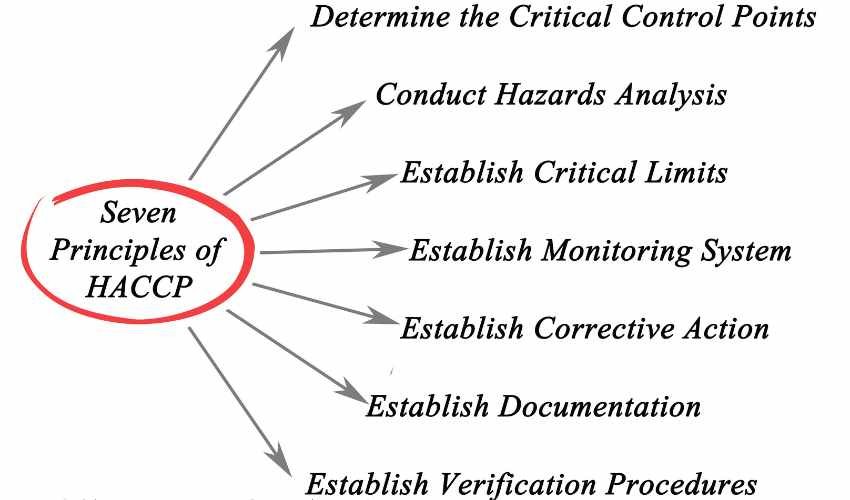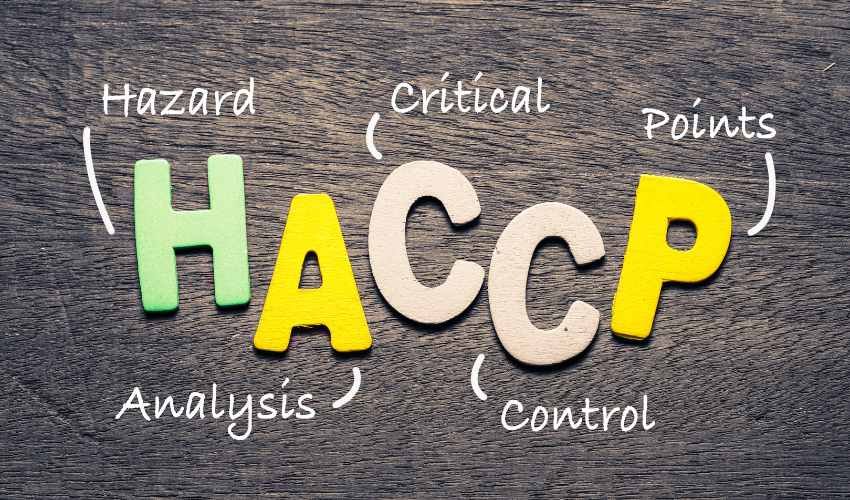
What Is HACCP Prerequisite Programs?
Ensuring the safety and quality of products is crucial in the ever-changing world of food manufacturing. A methodical technique called Hazard Analysis and Critical Control Points (HACCP) is used to recognize and control any risks in the food production process. The application of preparatory programs and foundational measures that establish a strong foundation for food safety is essential to the success of HACCP. This in-depth manual will explore the vital elements of HACCP Prerequisite Programs, highlighting their importance and demonstrating how they support a more secure and safe food supply chain.
What are the Prerequisites Programs for HACCP?
HACCP Prerequisites Programs provide a range of essential actions and procedures that serve as the cornerstone of an effective HACCP system. To establish a hygienic and secure environment for food production, these programs concentrate on general hygiene, facility maintenance, and operational standards. Prerequisite programs establish the foundation by addressing general food safety issues, while the HACCP plan addresses specific dangers in the production process.
The Pillars of HACCP Prerequisites Programs
Food companies undertake foundational measures known as " Food safety prerequisite programs " to create a sanitary and safe environment for food production. These initiatives are crucial parts of an all-encompassing food safety management system that reduces hazards to food safety by coordinating with the Hazard Analysis and Critical Control Points (HACCP) strategy. The following are typical HACCP prerequisite programs:
Good Manufacturing Practices (GMP)
The foundation of necessary programs is GMP, which emphasizes the application of standard operating procedures and hygiene. This includes keeping the premises tidy, ensuring staff members are clean, properly maintaining equipment, and using efficient pest control techniques.
- Personal hygiene: Set standards for hand washing, appropriate clothing, and grooming for staff members.
- Facility sanitation: Putting policies in place to clean and sanitize workspaces, tools, and cutlery to avoid contamination.
- Pest control refers to implementing strategies such as routine inspections, pest-proofing, and pest management techniques to prevent and control pests within the facility.
- Equipment maintenance: Equipment maintenance is known as establishing procedures for calibrating and maintaining equipment to guarantee correct operation and avoid cross-contamination.
- Allergen control refers to applying practices such as labelling, cleaning guidelines, and ingredient segregation that prevent allergenic and non-allergic substances from coming into contact with one another.
Sanitation Standard Operating Procedures (SSOP)
SSOP specifies precise cleaning and sanitization protocols for utensils, surfaces, and equipment to avoid cross-contamination and preserve a clean processing environment. Proper sanitation procedures are crucial to preventing pollutants from entering food manufacturing.
- Cleaning schedules: Create regular cleaning schedules with cleaning products, techniques, and frequency for various facility locations, equipment, and utensils.
- Sanitation procedures: Record the precise methods for cleaning and disinfecting specific equipment and surfaces, including pre-and post-operational sanitation activities.
- Verification and validation: Putting systems in place to use ATP testing, microbiological sampling, visual inspections, and other validation techniques to confirm the efficacy of sanitation operations.
Supplier Approval and Control
Guaranteeing the quality and safety of raw materials and packaging supplies is essential. Required conditions Programs contain procedures for vetting and monitoring suppliers to avoid risks during the production process.
- Supplier qualification: Supplier qualification defines the standards by which suppliers are chosen and approved by quality assurance procedures, food safety regulations, and other needs.
- Supplier audits: To guarantee adherence to defined criteria, conduct routine audits or evaluations of suppliers' facilities, procedures, and records.
- Supplier monitoring: Establishing policies to monitor and record suppliers' performance, including their response to corrective action, product quality, and delivery dependability.
Allergen Control Program:
- Allergen management plan: Create a thorough strategy to recognize, handle, and regulate allergens at every manufacturing stage, from sourcing ingredients to packaging and labelling.
- Allergen labelling: ensuring that allergenic components are accurately and clearly labelled on product labels, including allergen declarations, precautionary labelling, and allergen statements.
- Allergen training: Teaching staff members how to identify allergenic components, handle them safely, and take precautions to avoid cross-contamination.
Traceability and Recall Procedures
- Traceability systems: Systems for tracing raw materials, ingredients, and completed goods along the supply chain: putting in place systems for batch tracking, lot codes, and product identification.
- Recall procedures: Procedures for initiating and carrying out product recalls in the event of contamination, safety concerns, or other emergencies: creating and testing communication methods, recall notifications, and corrective actions.
These are only a few examples of prerequisite programs the food industry frequently uses to guarantee the quality and safety of its goods. Each program is created to fit the company's unique demands and is intended to work in tandem with the Hazard Analysis and Critical Control Points (HACCP) strategy to successfully manage the risks associated with food safety.
These food safety prerequisite programs are crucial for guaranteeing the quality and safety of food products, and they are usually designed to meet the unique needs and specifications of each food industry. Food enterprises can build a solid food safety and regulatory compliance foundation by successfully implementing these HACCP prerequisite programs.
Interplay Between HACCP Prerequisites Programs and HACCP Plan
Prerequisite programs concentrate on laying the groundwork for food safety, whereas the HACCP plan adopts a more focused strategy. The HACCP plan defines critical control points to monitor and control specific hazards related to a certain product or process. Prerequisites Programs and the HACCP plan work together to ensure a comprehensive and efficient food safety management system.

Implementing HACCP Prerequisites Programs
Assessing Current Practices
Analyze the facility's present procedures in detail. Determine which areas need improvement to comply with SSOP, GMP, and other requirements program elements.
Creating Standard Operating Procedures
Create concise and understandable standard operating procedures based on SSOP, GMP, and other requirements. All personnel participating in the production process should have easy access to and comprehension of these procedures.
Employee Training and Engagement
Establish thorough training initiatives to inform staff members of the value of required courses. To ensure that everyone understands the importance of food safety, training should include SSOP protocols, GMP principles, and other pertinent topics.
Fostering a Culture of Compliance
Promote an environment of accountability and compliance among staff members. Stress how important it is for them to uphold food safety regulations and how their actions affect the overall quality of the product.
Continuous Monitoring and Improvement
Regular Audits
Conduct routine internal audits to evaluate the Prerequisites Programs' efficacy. These audits guarantee continued adherence to set standards and assist in pinpointing areas in need of improvement.
Corrective Actions
Take immediate remedial action in response to audit results or deviations from standard operating procedures. This proactive strategy aids in preserving the system's integrity for managing food safety.
Benefits of HACCP Prerequisites Programs
Enhanced Food Safety
Putting Prerequisites Programs into Place improves overall cleanliness and operational procedures, significantly improving food safety. As a result, there is less chance of contamination, and safe, high-quality food products are produced.
Regulatory Compliance
In many jurisdictions, compliance with prerequisite programs is typically mandated by regulations. In addition to guaranteeing legal compliance, compliance is a foundation for gaining and retaining the required certifications.
Improved Operational Efficiency
Prerequisites Programs provide standardized and effective processes, which enhance total operational efficiency. This leads to lower waste, more production, and cost-effectiveness in the long term.
Consumer Trust and Brand Reputation
By putting Prerequisites Programs in place, a company can increase consumer trust and improve its reputation for food safety. A good reputation is beneficial since consumers are becoming more aware of the safety and calibre of the goods they use.

Challenges and Solutions
Resistance to Change
Employees might have to alter customary procedures. Stress the benefits of precondition programs for the workplace while addressing this issue with thorough training and communication.
Resource Allocation
It could not be easy to allocate funds to implement prerequisite programs. However, long-term cost benefits are achievable for firms with increased productivity and lower chances of product recall or fines from the government.
Conclusion
Programs for HACCP Prerequisites are essential for laying the foundation for a robust food safety management system. Through the implementation of general hygiene practices, facility upkeep, and operational standards, these programs aid in the production of food items that are safe and of superior quality. Businesses that make putting HACCP Prerequisites Programs into practice a top priority comply with regulations and provide the groundwork for long-term success in the cutthroat food sector, consumer trust, and operational excellence.
HACCP Prerequisites Programs FAQs
How many HACCP prerequisites are there?
Regulatory regulations, the industrial sector, and the needs of a food business might all influence how many HACCP Prerequisites Programs are needed. Nonetheless, a thorough food safety management system usually has several standard requirements. These may consist of:
- Good Manufacturing Practices (GMP)
- Sanitation Standard Operating Procedures (SSOP)
- Supplier Approval and Control
- Allergen Control Program
- Traceability and Recall Procedures
- Facility and Equipment Maintenance
- Personnel Training and Hygiene
- Water Quality Control
- Pest Control Program
- Waste Management Program
What is the list of prerequisite programs for HACCP?
Here's a list of Pre-requisite programmes for HACCP (Hazard Analysis and Critical Control Points):
Good Manufacturing Practices (GMP):
- Personnel hygiene
- Facility sanitation
- Equipment maintenance
- Pest control
- Allergen control
- Training programs
Sanitation Standard Operating Procedures (SSOP):
- Cleaning schedules
- Sanitization procedures
- Verification and validation
Supplier Approval and Control:
- Supplier qualification
- Supplier audits
- Supplier monitoring
Allergen Control Program:
- Allergen management plan
- Allergen labelling
- Allergen training
Traceability and Recall Procedures:
- Traceability systems
- Recall procedures
- Product identification
Facility and Equipment Maintenance:
- Maintenance schedules
- Calibration and verification
- Infrastructure maintenance
Personnel Training and Hygiene:
- Training programs
- Personal hygiene policies
- Illness reporting procedures
Water Quality Control:
- Source water verification
- Water handling procedures
- Water quality monitoring
Pest Control Program:
- Pest prevention measures
- Pest management procedures
- Regular inspections
Waste Management Program:
- Waste handling procedures
- Waste reduction measures
- Recycling and reuse initiatives
Together with the HACCP plan, these necessary programs serve as the cornerstone of an all-encompassing food safety management system, assisting in identifying and mitigating hazards throughout the food production process. Every program is designed to meet the unique demands and specifications of the food industry and is essential to guaranteeing the security and calibre of food items.
What are HACCP prerequisites?
Programs that are prerequisites for HACCP include fundamental safeguards for food safety. Good Manufacturing Practices (GMP), Sanitation Standard Operating Procedures (SSOP), allergen control programs, supplier approval and control, traceability and recall procedures, facility and equipment maintenance, employee hygiene and training, water quality control, pest control programs, and waste management are examples of common prerequisites. These requirements create a clean environment, guarantee that ingredients are handled properly, and reduce risks. They also provide the framework for an efficient HACCP plan to detect and manage particular hazards in the food manufacturing process.
Why HACCP prerequisite program checklist is helpful?
Developing a preliminary program checklist for HACCP (Hazard Analysis and Critical Control Points) is crucial to guarantee that all the procedures required to provide a clean and safe food production environment are in place.
What are 7 prerequisite programs haccp?
Good Manufacturing Practices (GMP), Sanitation Standard Operating Procedures (SSOP), supplier approval and control, allergen control, traceability and recall procedures, facility and equipment maintenance, personnel training, and hygiene are all included in the seven prerequisite programs for HACCP (Hazard Analysis and Critical Control Points). GMP guarantees hygienic staff practices and appropriate facility operations. SSOP establishes protocols for cleaning and sanitizing. Supplier compliance is confirmed by supplier clearance and control. Allergen cross-contact is avoided through allergen control. Product tracking is ensured by traceability and recall processes. Operational integrity is maintained by facility and equipment maintenance. The cornerstone for successful HACCP implementation and food safety assurance is laid by personnel training and hygiene, which inform and uphold appropriate procedures.
How can Arnika help you with HACCP?
Arnika can be instrumental in supporting HACCP prerequisite programs in several ways:
- Documentation Management: Arnika can help with the arrangement and administration of paperwork about precursor programs, including policies, records, logs, and standard operating procedures (SOPs).
- Training: Arnika can provide staff training sessions on prerequisite programs, ensuring they understand the significance of these initiatives and know how to carry them out successfully.
- Audits and Inspections: Arnika can assist with arranging and carrying out internal audits and inspections to ensure that program prerequisites are met and pinpoint areas that need improvement.
- Risk Assessment: Arnika can assist in carrying out risk analyses to pinpoint any dangers in the food production process and choose the best preventative actions.
- Monitoring and Verification: Arnika can help create protocols for monitoring and verifying that identified hazards are controlled appropriately and successfully by implementing prerequisite programs.
- Continuous Improvement: By evaluating data, seeing trends, and taking appropriate corrective and preventive action when needed, Arnika can assist in setting up procedures for enhancing prerequisite programs.
Organizations can improve their HACCP prerequisite programs, reduce risks, and guarantee the quality and safety of their food products by utilizing Anika's capabilities.
